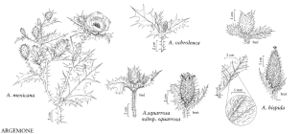Difference between revisions of "Argemone ochroleuca"
Brit. Fl. Gard. 3: plate 242. 1828.
imported>Volume Importer |
imported>Volume Importer |
||
| Line 59: | Line 59: | ||
|publication year=1828 | |publication year=1828 | ||
|special status=Illustrated;Introduced | |special status=Illustrated;Introduced | ||
| − | |source xml=https:// | + | |source xml=https://bitbucket.org/aafc-mbb/fna-data-curation/src/2e0870ddd59836b60bcf96646a41e87ea5a5943a/coarse_grained_fna_xml/V3/V3_206.xml |
|genus=Argemone | |genus=Argemone | ||
|species=Argemone ochroleuca | |species=Argemone ochroleuca | ||
Latest revision as of 21:47, 5 November 2020
Plants annual or short-lived perennial. Stems branching distally, 3-10 dm, sparingly prickly. Leaf blades: abaxial surface sparingly prickly on veins, adaxial surface usually unarmed; proximal deeply lobed nearly to midrib; distal more shallowly lobed, usually clasping. Inflorescences: buds oblong, body 8-18 × 4-11 mm, with 4-10 prickles per sepal; sepal horns terete, 5-12 mm, unarmed. Flowers 3-7 cm broad, closely subtended by 1-2 foliaceous bracts; petals lemon yellow or rarely darker yellow; stamens 20-75; filaments yellow; pistil 3-6-carpellate. Capsules ovoid-ellipsoid to oblong, 20-50 × 10-18 mm (including stigma and excluding prickles), longest prickles 8-12 mm. Seeds 1.5-2 mm. 2n = 56.
Phenology: Flowering and fruiting spring–fall.
Habitat: Disturbed soil, often a weed of fields, roadways, embankments, intermountain plains
Elevation: 0-2250 m
Distribution

Introduced; Ariz., Mexico.
Discussion
Argemone ochroleuca is widespread in temperate and tropical regions of the world as an introduced weed.
Selected References
None.
